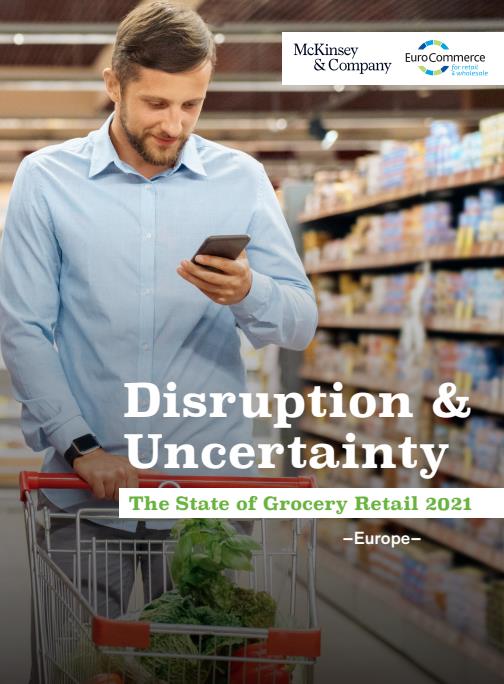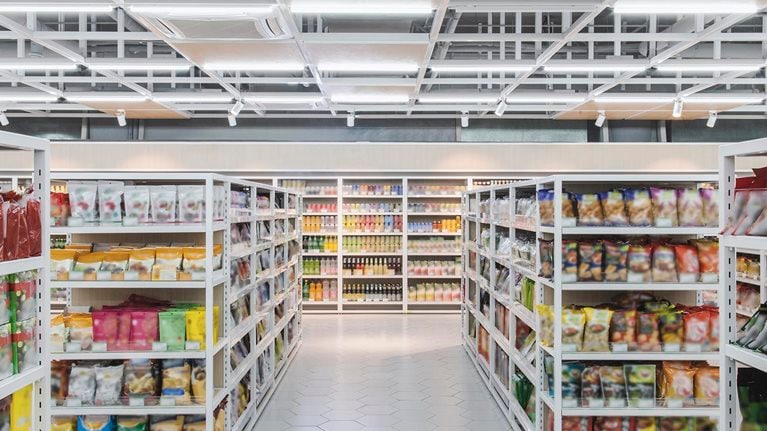The following is an excerpt from the full report that focuses on what's in store for grocery retail in 2021. For a comprehensive backward-looking analysis of how the COVID-19 pandemic has reshaped the European grocery retail landscape along five major forces in 2020, as well as detailed analyses of specific trends, please download the full report.
Consumer shifts around online, value, and lifestyle agendas are creating an attractive opportunity for grocery retailers to capture market shares over the next two to three years. However, both the growth of online and the trend toward value are likely to put further pressure on grocers’ margins, especially given that the overall market may shrink once restaurants return. Grocery retailers thus will need to strive for further efficiency and find new margin pools to grow profitably.
In January 2021, EuroCommerce and McKinsey conducted grocery retail surveys across Europe (see sidebar, “About the research”). The research identified ten trends we expect to shape the grocery retail market in the coming years (Exhibit 1). The essence of these trends is shaped by three key shifts: online becomes core, value is king again (downtrading), and consumer lifestyle agendas drive demand through a focus on health, sustainability, and convenience food. These shifts emerged as consistent patterns across most European markets. Low-income consumer segments trend more toward downtrading, while high-income segments trend more toward online and lifestyle-driven products. But all the shifts are emerging to some extent across income groups.

The combination of continued online growth after the penetration spike in 2020 with shifts to value or downtrading and from grocery sales back to restaurants is very likely to put more pressure on grocers’ profitability. They will need to further increase their efficiency—through automation, for example, or an evolved online business—and find new pools of margin, through analytics or a shift to more differentiated, premium-type products. These trends are a top concern for many of the CEOs we surveyed.
A declining market?
Following a record year for sales in 2020, the CEOs and consumers we surveyed expect that the European grocery market will stagnate or decline over the next one to two years as COVID-19 restrictions are lifted. However, consumers plan to keep spending more on groceries after the pandemic subsides compared with before the pandemic, suggesting that the market will not return fully to pre-COVID-19 levels but will remain slightly larger. The timing and magnitude of the likely future contraction of the market are highly uncertain and dependent on several factors linked to the further evolution of the COVID-19 crisis.
In line with this, nearly half of CEOs expect that the market situation will worsen in 2021 and remain highly uncertain. Just 26 percent anticipate that the situation will improve. The words CEOs most commonly associate with their expectations for 2021 are “challenging,” “uncertain,” “price-focused,” “competitive,” and “online” (Exhibit 2).

Consumers indicated that they plan to maintain some of their changed behaviors in the postpandemic era. In particular, up to 10 percent of consumers said they intend to keep spending more on grocery stores and less on other food channels than they did pre- COVID-19. This could be because consumers have become more accustomed to cooking at home or because they expect to keep working from home more than they did in the past (Exhibit 3).

Key trends shaping the industry
Based on both CEO surveys and consumer research, we identified ten trends that we believe will shape the industry over the next years. This analysis is based on what CEOs see as the key industry-shaping changes (Exhibit 4) and the shopping intentions of consumers (Exhibit 5).


The most pronounced trends show that online is becoming core for grocery retailers, value is king again, and lifestyle agendas are driving food demand.
Online becomes core
Following an exceptional take-up rate for online shopping in 2020, consumers are eager to make even more of their food purchases online in 2021. In particular, the 25 percent of consumers who already bought online at least occasionally want to increase their online purchasing even further. The more often consumers bought online in 2020, the more likely they seem to be to increase their share of online buying (Exhibit 6).

However, the trend toward increased online shopping does not extend to all consumer groups. Consumers who rarely purchased food online in the past (10 percent of all consumers) said they plan to cut rather than increase their online spending (–4 percent net intent). And of the consumers who did not shop online in 2020—the clear majority at 65 percent—only 7 percent said they intend to start buying online in 2021.
Less frequent online shoppers may have had to resort to online grocery shopping in 2020 and found the experience disappointing, which could explain their reluctance to continue shopping online in 2021. When non-online and rare-online shoppers were asked what is preventing them from buying online, 49 percent indicated they preferred personal contact in stores, 33 percent think delivery charges are too expensive, and 22 percent said minimum order requirements are too high.
CEOs rank the accelerated growth of online channels as their second most important priority. They also see a need to improve online profitability (ranked sixth).
Value is king (again)
CEOs see downtrading, or increased price sensitivity, as the most influential trend for the grocery market, with 56 percent of CEOs listing it among their top three priorities. The downtrading trend is amplified by an increased quality expectation of consumers at the entry-level price tier (ranked at number seven in the CEO survey), as it puts pressure on grocery retailers regarding both price and quality.
Our consumer survey confirms this downtrading trend. Across Europe, net 34 percent of consumers indicated that they want to save money when shopping in 2021 compared with 2020, 27 percent plan to research promotions more actively, and 17 percent want to switch to less-expensive products.
Lifestyle agendas drive food demand
The COVID-19 crisis accelerated the trend toward more healthy, sustainable, and local products with no apparent slowdown so far. Across Europe, net 30 percent of respondents plan to focus more on healthy eating and nutrition in 2021 compared with 2020, 24 percent plan to spend more on regional and local products, and 19 percent plan to spend more on environmentally friendly products. These effects continue to be strongly influenced by individual economic situations.
Higher-income segments tend to be less price conscious and more willing to spend on healthy eating and nutrition. In contrast, lower-income segments focus more on saving money and are less concerned about healthy food choices (Exhibit 7).

The consumer survey results confirm CEOs’ expectations of overall trends toward price sensitivity and healthy products. The findings also illustrate the continued polarization across consumer segments seen in 2020, with lower-income consumers expecting to focus more on saving money and overall downtrading, while higher-income segments’ product preferences may drive them to overall uptrading despite increasing price sensitivity.
Implications for grocers
All three of these key consumer shifts represent excellent opportunities for grocery retailers to win new customers. These shifts are happening at substantially greater magnitude and speed than ever before and could lead to significant changes in market share over the coming years. Smaller players could win by excelling in one or two of these areas and nurturing their niche. However, leading grocery retailers will have a hard time keeping or winning market shares unless they excel in all three dimensions.
While all grocery retailers are likely to work on capturing these trends, executives should examine whether their efforts are ambitious and fast enough to win. We see some retailers making bold moves—for example, introducing new health-focused private labels or expanding and improving their opening-price-point assortments. Others are reorganizing their businesses to substantially reallocate resources to online.
Value becoming king, online becoming core, and the return of restaurants will put pressure on the profitability of retailers. While the push for value-added or premium products will counter some of this, retailers will likely have to make substantial efforts to maintain their profitability. Retailers need to further reduce their costs and find new margin pools to tap. Supply chain and back-office process automation can be one lever to do so. In addition, advanced analytics offer the opportunity to identify new margin pools and further optimize profitability (for example, through more personalized offerings or optimized prices and promotions). In particular, assortment planning at a more granular level (even down to local or store-specific assortments) to better reflect the dynamics in the individual store’s catchment area might offer significant potential, given that the polarization of consumers is likely to further increase.



